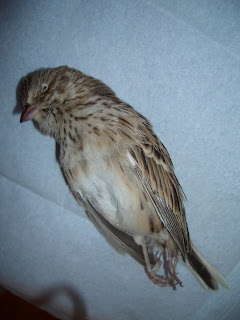photographs courtesy of Carolyn Ohl-Johnson

At Gage Hotel. It was/is often in the Mexican Elder that is behind the restaurant. Near this tree is also a fountain and organic tomatoes and dill.
It also spends time in the large elm in front of the restaurant patio
**NOTE: This male is, ofcourse, in non-breeding plumage and likely a young of the year.
On the state list-serv, TEX-BIRDS:
"Matt called me this morning to let me know about a BAY-BREASTED WARBLER at the Gage Hotel; my brief attempt was fruitless on my way into town, but this afternoon he had two more sightings of it for a total of 20 minutes with bins. It's a nonbreeding adult male; notes taken, no photos yet. This is a great fall record!
It's frequenting a Mexican Elder tree behind the restaurant/bar at the Gage Hotel. Hopefully it'll stick around until this next front moves through on Thursday!
Happy trails, -h
Heidi Trudell & Matt York Marathon, TX "

On the North American Rare Bird Alert:
Texas Rare Bird Alert...
"TEXAS INTERIOR - Non-Review Species
New: Marathon: Bay-breasted Warbler -- first sighting: Oct 25On the morning of Oct 25 Matthew York found a Bay-breasted Warbler (nonbreeding adult male) at the Gage Hotel in Marathon. He relocated the bird in the afternoon for 2 more sightings (last one at 4:25pm). The bird was frequenting a Mexican elder tree behind the restaurant/bar at the hotel. The address of the hotel is 102 NW 1st St - US Hwy 90 West."
So, for more information about Bay-breasted Warbler (Dendroica castanea) here are some links:
http://www.allaboutbirds.org/guide/Bay-breasted_Warbler/id
http://en.wikipedia.org/wiki/Bay-breasted_Warbler
http://audubon2.org/watchlist/viewSpecies.jsp?id=17

The following is a range map:

Check out the legend on the map.
The bird checklist I mostly use for the trans-Pecos region is Birds of the Trans-Pecos. a field checklist. Texas Parks and Wildlife. authored by Kelly B. Bryan, 2002.
It lists Bay-Breasted Warbler occurance only as "Accidental" in the months of April and May.
"Accidental" = "generally one to three records region-wide each decade."
Nice. Marathon. Late October. Gage Hotel.
Looking back at that range map, I can't help but wonder, "How far north did it spend the summer?"
I hope it's there tomorrow. Cold front blowing through on Thursday might help motivate it to continue on down to South America.

**As of 6 November 2011, the Bay-breasted Warbler is still here. It is often seen at the huge elm out front, between the historical building and the restaurant. **














